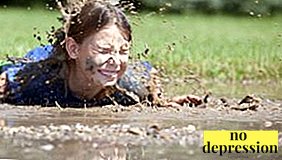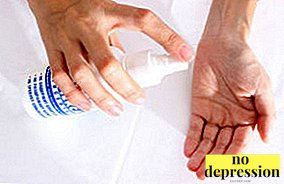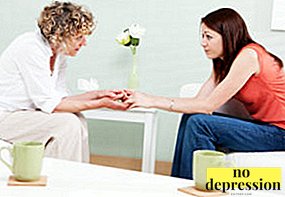Misophobia - this pathological fear of getting dirty, becoming infected with a dangerous disease.
Therefore, people who have this phobia, avoid touching the fact that it seems to them dirty, germinated: handrails in public transport, door handles, the skin of other people, pet hair.
General information

What is misophobia? This phobia is also called hermophobia - fear of microbes.
It is widespread in the world, especially in the USA and other developed countries of the world.
Due to the nature of life city residents this phobia occurs more often than rural.
A person suffering from misophobia seeks with all his might protect yourself from the influence of microbestherefore, he often washes his hands, may constantly wear medical gloves or wear them before contact with what, in his opinion, may be populated by pathogenic microorganisms, carry antiseptics (napkins, sprays) with them and process them with what is to be contacted .
But one should not confuse misophobia with the obsessive desire to wash hands, which is a symptom of obsessive-compulsive disorder: according to psychotherapists, a person with OCD, first of all thinks not about germs and infection, but about how to wash his hands.
But in practice, misophobia and obsessive-compulsive disorder may intersect.
Like other phobias, germphobia can have different features, depending on the personality and biography of a particular person.
For example, one hermophob is afraid to contact with door handles, handrails and other objects in public places, but people's skin and house dust scare him less, and the other experiences the same horror at the thought of contact with skin and dust, and touching it. items that he is not sure about.
Many famous people, for example Cameron Diaz, Vladimir Mayakovsky, Nikola Tesla, have or had this phobia.
Facts about microbial fear in this video:
Causes of development
The main reasons for the appearance of pathological fear:
 Children's injuries. Many phobias originate in childhood. If a child is an impressionable, even a popular science program about microbes or infectious diseases transmitted by contact or airborne droplets, it can leave behind a trauma. Mysophobia is also more susceptible to people who were beaten, humiliated, and ashamed as children.
Children's injuries. Many phobias originate in childhood. If a child is an impressionable, even a popular science program about microbes or infectious diseases transmitted by contact or airborne droplets, it can leave behind a trauma. Mysophobia is also more susceptible to people who were beaten, humiliated, and ashamed as children.- Personality Features. Anxious, suspicious people more often than others suffer from phobias and other mental disorders. They are more suggestible, so the information broadcast by the media noticeably scares them. In addition, mizophobia and other pathological fears occur more often in those who are in constant stress (regular stress, neurosis), experienced severe events (illness and death of loved ones, separation from a loved one, acute episodes of sexual, physical and mental violence).
- The presence of misophobes in the number of loved ones. This is especially true of parents who are able to convey their fear to the child. Many of them repeatedly express their concerns about microbes to children and tend to over-monitor the hygiene of family members. The child also sees how parents interact with the world (they wear gloves, masks, constantly wipe objects with napkins), notices their panic attacks, and gradually information is fixed in his mind that microbes are terrible and that everything possible should be done to avoid contact with them.
- Negative experience. For example, a person could previously pick up a serious infectious disease and heal for a long time from it. As a result, this led to the fact that he began to be in panic afraid of everything connected with microbes, for fear of getting sick again with something dangerous. Another phobia could develop if a close person fell ill.
But the key reason for the fear of microbes is awareness of infectious diseases and pathogenic microorganisms, and this information is not always close to reality.
 Media focus on shocking information, which causes a strong response from people, often show the facts in a dark light and even distort them, giving the consumer excessively embellished and therefore inaccurate information in the pursuit of profit.
Media focus on shocking information, which causes a strong response from people, often show the facts in a dark light and even distort them, giving the consumer excessively embellished and therefore inaccurate information in the pursuit of profit.
Also aggravate the situation Antiseptic Manufacturerswhich, by promoting their products, tend to show germs as dangerous as possible.
Some people suffer from misophobia because they do not have enough information about certain phenomena.
For example, they may not be aware of how the immune system works, how dangerous diseases such as AIDS, hepatitis C, tuberculosis and others are transmitted. Even in the civilized world, people do not always know that AIDS not transmitted by contactor do not want to believe it.
What microbes are actually dangerous to humans? Top most dangerous:
Characteristic symptoms and signs
Key signs of misophobia:
 Frequent hand washing. A misophobe can wash its hands so often that it has problems with the skin on them: it dries, flakes and requires additional treatment with moisturizers. Many hermophobes constantly wear medical gloves or wear them as needed.
Frequent hand washing. A misophobe can wash its hands so often that it has problems with the skin on them: it dries, flakes and requires additional treatment with moisturizers. Many hermophobes constantly wear medical gloves or wear them as needed.- Avoiding anything that could be associated with pollution. Mysophobes avoid using public toilets and transportation. In some cases, the phobia is so strong that the misophobe does not leave the house.
- Excessive use of antiseptics. If a person with a misophobia still left his house, he almost always has wet wipes and sprays. He regularly wipes items on the workplace, door handles, sinks, his clothes, hands.
- The desire to create sterility around them. Hermophobes are always very clean in the apartment, and they also regularly use a large number of antiseptics when cleaning the house.
- Rejection of contact with animals and people. Because of the fear, the hermofobes close in themselves, avoid communication, including romantic ones. They can wind up animals, but also over-monitor their cleanliness, while others avoid street animals and pets.
- Changes in physical condition. When misophobes think about germs, see dirt, accidentally contact with a non-sterile object, they experience panic fear, which is accompanied by characteristic somatic symptoms: nausea, vomiting, increased heart rate, weakness, tremors, dizziness, and lack of air. They are thrown into heat or cold, and in rare cases they may even lose consciousness.
Any pollution causes them anxiety, so they clean it daily.

All this is strong makes life difficult misophobia
They find it difficult to finish their studies, get a job, have friendly or romantic relationships, and the world outside the home seems to them an extremely dangerous place.
They often face misunderstandings from other people who notice their oddities. Some hermofobes don't have a family because they are too afraid of close physical contact.
Constant ridicule, bewilderment, insults emanating from other people, even close ones, cause mizophobes withdraw into yourself completely which also negatively affects their psycho-emotional state and causes the development of other mental problems, including hypochondria, social phobia, depression, neurosis, obsessive-compulsive disorder, panic disorder, various complexes.
And since the mental state is closely related to the physical, they often get sick. Therefore, it is important to recognize mizophobia in time and begin treatment.
Why do we need feeling of disgust? Find out from the video:
Treatment methods
Pharmaceutical and psychotherapeutic methods are used in the treatment of misophobia.
Medications

Medications:
- antidepressants. They reduce the severity of anxiety, improve sleep, have a positive effect on mood, reduce emotional stress. Examples: Zoloft, Prozac;
- neuroleptics, usually atypical. They are connected in the presence of side disorders that are directly related to the phobia, for example, in the presence of obsessive-compulsive disorder, and in cases where the classical treatment regimen is ineffective. Examples: Risperidone, Quetiapine;
- beta blockers. Effectively block the somatic manifestations of phobias, because they affect adrenaline receptors. Examples: Metoprolol, bisoprolol;
- sedatives and tranquilizers from the benzodiazepine group. Eliminate anxiety, improve sleep. Examples: Novo-Passit, Clonazepam, Diazepam.
But without adequate psychotherapeutic help, the medicines are useless. They block some of the symptoms, but after withdrawal or lower dosage, fear returns.
Combinations of drugs are selected by the attending physician depending on the individual situation.
Psychotherapy
Psychotherapeutic methods:
 exposure method. The misophobe is in contact with what scares him (for example, looking at images), but this happens in the presence of a psychotherapist who talks to him everything that disturbs him and gradually the phobia diminishes;
exposure method. The misophobe is in contact with what scares him (for example, looking at images), but this happens in the presence of a psychotherapist who talks to him everything that disturbs him and gradually the phobia diminishes;- cognitive behavioral psychotherapy. The methods are based on keeping records in accordance with the methodology, homework, conversations with a psychotherapist. It helps a person understand that his fear is irrational, and get rid of him;
- opposition method. The standard reaction to contact with what scares is panic, fear. The method of opposition is based on the fact that a person needs to learn to give out on contact with what scares, the exact opposite reaction. The patient is taught the methods of self-relaxation, which he uses when he is scared, and in moments of fear he tries to feel calm.
Recommendations
Recommendations for people with misophobia:
- Avoid what makes people afraid of germs and dirt, something that even with a successful start of treatment can make you feel panic again. As trigger - a trigger that activates fear, - an article on the Internet about an infectious disease, a comment on a forum about diseases, a popular science program about pathogenic microorganisms can be made.
- Be patient: a few days from a phobia that has been preserved for years, you cannot get rid of. Prepare yourself to think that the treatment will not be short, and do not leave it without good reason.
- Carefully stick to everyone doctor's instructions, do your homework, even if for some reason they seem ridiculous to you, and the fear will decrease with time.

Forecast depends on many factors: the characteristics of the phobia, the personality of the patient, the professionalism of the psychotherapist, the causes of fear, the chosen methods and medicines.
And properly chosen treatment can eliminate or significantly reduce the phobia, it is only important to start it as soon as possible.
How to get rid of the fear of infections and germs? Psychologist tips:

 Children's injuries. Many phobias originate in childhood. If a child is an impressionable, even a popular science program about microbes or infectious diseases transmitted by contact or airborne droplets, it can leave behind a trauma. Mysophobia is also more susceptible to people who were beaten, humiliated, and ashamed as children.
Children's injuries. Many phobias originate in childhood. If a child is an impressionable, even a popular science program about microbes or infectious diseases transmitted by contact or airborne droplets, it can leave behind a trauma. Mysophobia is also more susceptible to people who were beaten, humiliated, and ashamed as children. Frequent hand washing. A misophobe can wash its hands so often that it has problems with the skin on them: it dries, flakes and requires additional treatment with moisturizers. Many hermophobes constantly wear medical gloves or wear them as needed.
Frequent hand washing. A misophobe can wash its hands so often that it has problems with the skin on them: it dries, flakes and requires additional treatment with moisturizers. Many hermophobes constantly wear medical gloves or wear them as needed. exposure method. The misophobe is in contact with what scares him (for example, looking at images), but this happens in the presence of a psychotherapist who talks to him everything that disturbs him and gradually the phobia diminishes;
exposure method. The misophobe is in contact with what scares him (for example, looking at images), but this happens in the presence of a psychotherapist who talks to him everything that disturbs him and gradually the phobia diminishes;

